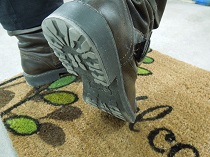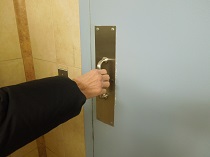This post may contain affiliate links. Please read my disclosure.
Who doesn’t like going in to public restrooms because of all the germs in there! If you’re like me you probably avoid touching the handles of the stall door, use a paper towel to turn on the faucet and maybe even flush the toilet with your foot. But although public bathrooms seem like the worst place, there are many other “spots” to watch out for! Especially this time of year, when we are all closed up due to the cold temperatures, this is when the little buggers are out in full force!
Although this is cause for concern, we shouldn’t run around with our hands in the air about germs! Don’t forget, we are fairly protected if we have a good immune system and wash our hands often. Just the same, they still get us and below are just some of the places where we need to protect ourselves. Before I bring up my list of some of the germiest places to watch out for, here are some facts about germs.
What is a germ and how long do germs stay on surfaces?
Germs may be a virus or a type of bacteria and how long they survive depends on what kind of germ they are. According to the CDC, influenza viruses may live on a surface for 2 to 8 hours. One site interviewed infectious disease specialist Dr. Don Goldmann of Children’s Hospital, Boston who said that cold viruses may live nearly 6 hours.
Names of some of the germs and bacteria you may find
Just in public restrooms you can find a multitude of viruses and bacteria. They are especially prevalent around the sinks because they thrive on the moist environment. Some of the most common ones you’ll find in public places are: streptococcus, hepatitis A virus, E. coli, cold virus, staphylococcus, along with some common sexually transmitted organisms. Not only can these viruses and bacteria be found in public bathrooms, but also on many other public surfaces that you need to watch out for!
How do cold viruses get in to us?
Bacteria and viruses usually take a free ride from our hands to our nose, eyes or mouth. So, the best way to prevent them from entering our body is to always make sure that if you happen to touch the germy surfaces, not to rub your eyes, nose, or touch your mouth.
Of course, another way germs are transported and make it in to your body is when you breathe air that contains moist drops from a sneeze or cough. This is how most flu viruses are easily spread.
List of Germiest Places:
1. Public Rest Rooms

2. Cell Phone

Hardly anyone ever cleans their cellphone, which is why it is one of the germiest places.
 
3. Bottom of Shoes

When you wear your shoes around your house these bacteria and organisms get transferred on to your floors and particles get released into the air. To minimize your exposure to these pathogens make sure to always remove your shoes at the door.
4. Pillow Cases

5. Computer Keyboard and Mouse

Your office computer is not so innocent, especially if people share it often. So if you’re looking for someone to blame for your cold, you may not have to look very far. This is one place that isn’t cleaned enough to keep germs to a minimum. Did you know that in 2007 the U.S. Centers for Disease Control and Prevention found that a mouse and keyboard in a first grade classroom had harbored the virus linked to the stomach flu causing an outbreak of that illness?
How do you clean it? Unplug and wipe down with a lint-free cloth, slightly damp with sterile water (boiled water for 20 minutes is not totally sterile but fine for this use). Next, turn upside down and shake to get rid of debris in between the keys. It’s a good idea to clean the keyboard after someone else has used it.
6. ATM/Gas Pump Handles

7. Door Handles

8. Shopping Carts

9. Doctor’s Offices – Instruments and Magazines

While you’re waiting in the doctors, you also may want to avoid the magazines in there as germs can live on paper. In Germany researchers found that 4 kinds of bacteria (such as E.coli and staph) survived on paper was still present after three days!
More Germiest Places:
10. Pens Used by the Public
11. Money
12. Toothbrushes Left Near/or in the same room as the Toilet
13. TV Remote
14. Handbags Left on the Floor
15. Keys (although keys made of brass offer some protection because it’s naturally antibacterial)
16. Kitchen Sponges
17. Cutting Boards for Meats
18. Yoga Mats
19. School Desks
20. Vending Machines
Do you try to avoid some of these germiest places?


Hi Lori,
I’m a “health extremist” like you and love the blog. This post, however, I didn’t find as strong as it could be.
Mostly, due to the ‘set up’ of the problem: “Especially this time of year, when we are all closed up due to the cold temperatures, this is when the little buggers are out in full force!”
It’s illogical to think “the little buggers” are out more in the winter than the summer. Bacteria and viruses are all around us (we have 100 trillion bacteria living in us, 10x the number of cells in our body!) but of course our immune function is weakened in the winter, mostly because we’re indoors, not getting Vitamin D from the sun, getting fresh air and exercise and breathing out any toxins we’ve taken in, etc. etc. We probably eat less fresh fruits and vegetables and just have less ability to “fight off” any invading ‘buggers’ as you say.
Sure it’s good to stay away from germy places, and sure it’s common messaging to wash your hands often. But let’s all work hard to keep our immune systems strong in the winter – get outside! get some sun! eat lots of soups and stews! – so even if you do intake a bacteria or virus, it’s in for a fight because your body’s natural “attack function” will work as it should 🙂